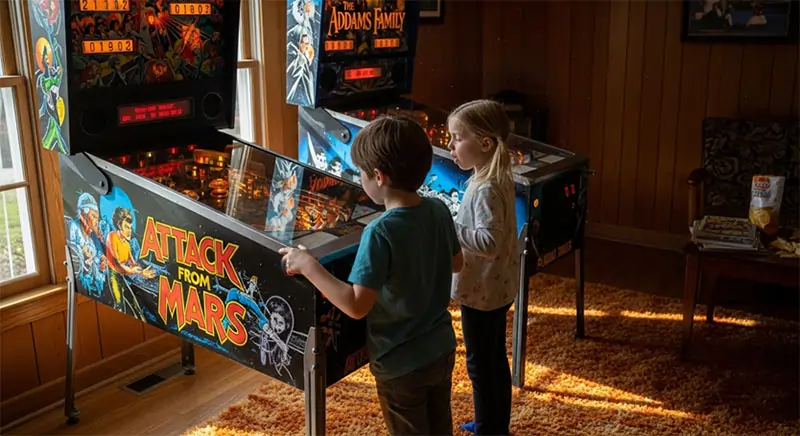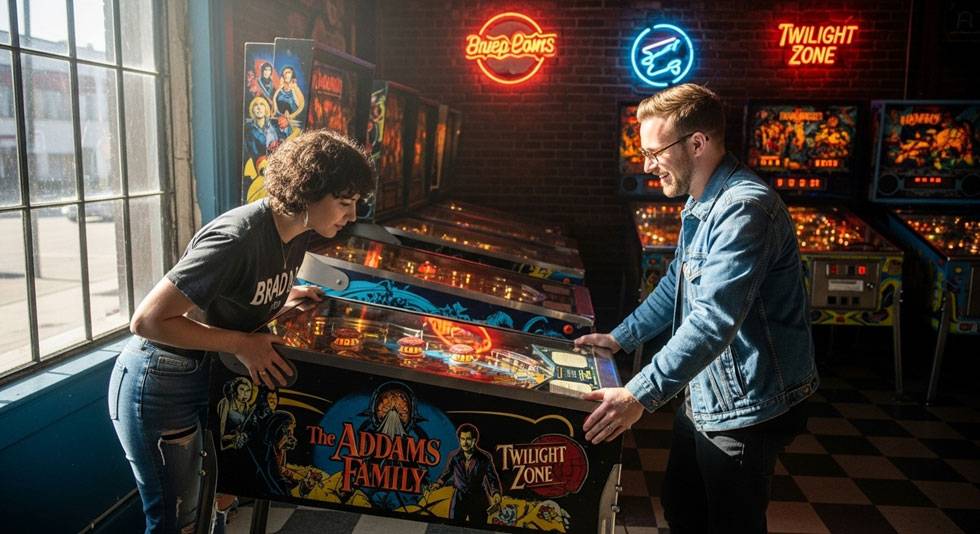How Home Pinball Machines Are Becoming Popular Again
In an age dominated by screens, many of us feel a profound disconnection from the physical world. Our days are spent staring, tapping, and typing a world of experience reduced to text on glass. In response, a quiet but powerful movement is building toward tangible hobbies that anchor us in the moment.
At the forefront of this movement is a surprising resurgence. Forget vinyl records and board games; the revival’s pulse is the flashing lights, kinetic energy, and satisfying clatter of the pinball machine, now finding a welcome home far beyond the old arcades.
Why is Tactile Entertainment Making a Comeback?
There’s a unique exhaustion that follows a day spent staring at screens. This digital fatigue sparks a craving for experiences that root us in the physical world. Hobbies built on touch, timing, and direct physical feedback are the antidote to the passive consumption of digital media. They demand a level of presence and engagement that passive scrolling actively erodes.
This craving for tangible interaction fuels the resurgence of analog pastimes. Like building a model, shaping clay, or stepping up to a gleaming new pinball machine, these activities forge a direct link between mind and machine. The weight of the steel ball, the vibration of the flippers, and the immediate consequence of every move this physical feedback loop creates an immersive reality, satisfying a primal need for hands-on engagement.”
What Cognitive Benefits Does Pinball Offer?
Pinball is more than a simple diversion; it is a profound mental exercise. The game commands a “flow state,” an intense focus so complete that the outside world simply melts away. More than just fun, it is potent stress relief, a mental recalibration that restores clarity to a demanding day.
This mental workout also hones distinct cognitive skills. A player must constantly make split-second decisions, predict trajectories, and devise complex strategies to dominate the game. Each game is a crucible that forges hand-eye coordination, sharpens spatial reasoning, and strengthens problem-solving abilities. It is a vigorous mental workout disguised as entertainment, yielding a sharper, more agile mind.
How Do Modern Machines Differ from a Classic Arcade?
Today’s machines are a world away from the simpler games you might remember. They blend classic mechanical satisfaction with modern technological depth, creating an experience that is both nostalgic and completely new. Here’s a closer look at what has changed:
Sophisticated Rules and Objectives
Modern games are built on deep, story-driven rules, boasting multiple modes, missions, and wizard-level challenges. Success demands both strategy and skill, turning each game into an intricate puzzle that rewards those who master its complex mechanics and layered goals.
Advanced Technology Integration
Static backglass art has given way to high-definition LCD screens that broadcast custom animations, scoring updates, and instructional videos. Intricate LED light shows and thunderous sound systems sync with these visuals, creating a cinematic atmosphere unique to each machine’s theme.
Community and Connectivity
Internet connectivity is now a standard feature, linking players to global leaderboards where they track high scores, earn achievements, and join community challenges. This technology transforms a solitary home experience into a global arena, weaving a compelling social and competitive layer into the game.
Where Can You Find the Right Machine for Your Space?
Finding the perfect machine is an approachable quest. For new models, authorized dealers provide the security of warranties and professional support. Beyond the showroom, a thriving secondhand market yields well-maintained classics and recent favorites. Online forums and enthusiast groups connect you with reputable private sellers and the hard-won wisdom of experienced owners.
Your first consideration should be the theme, whether it’s a blockbuster film or a legendary rock band. Next, evaluate the difficulty: some machines are built for immediate fun, while others demand mastery. Finally, measure your intended space with precision. Although most machines share a standard footprint, comfortable play requires ample surrounding space.
When is the Right Time to Invest in This Hobby?
The idea of owning a pinball machine can seem financially intimidating, leading many to believe it’s an inaccessible luxury. However, this perception often overlooks the diverse entry points available to new players. Let’s examine how to get started without breaking the bank.
Debunking the Price Myth
While a new, top-of-the-line machine is a major investment, the used market provides a vast spectrum of options. Here, well-loved electromechanical games from the 1970s and solid-state machines from the 80s and 90s sell for a fraction of their modern counterparts’ cost.
Starting with Virtual Options
For those hesitant to invest, digital pinball platforms on consoles or PCs provide the perfect entry point. These realistic simulations allow you to master hundreds of tables, learn intricate rules, and pinpoint your favorite game styles all before committing to a physical machine.

What is the Social Aspect of Home Pinball?
A pinball machine is more than just a game; it’s a social centerpiece. It acts as a kinetic fireplace or a lively kitchen island, a natural focal point that pulls people together. It creates an immediate, shared spectacle that captivates everyone, whether they are playing or simply watching. It sparks conversation and friendly competition with an energy that a television can seldom match.
Unlike passive entertainment, it demands interaction. Friends and family gather around, cheering on a great ball or laughing at a frustrating drain. This becomes the heart of the gathering, forging shared moments of triumph and frustration. It pulls people from the solitude of their private screens and unites them around a single, tangible spectacle.
Frequently Asked Questions
What’s the average maintenance required for a home machine?
Basic maintenance is surprisingly simple. It mostly involves regular cleaning of the playfield with a microfiber cloth and specific wax, along with replacing the pinballs every few hundred plays to prevent wear. Occasionally, a rubber ring may break or a lightbulb will burn out, both of which are easy fixes for owners.
How much space do I really need for a pinball machine?
A standard pinball machine is typically about 2.5 feet wide and 4.5 feet long. You’ll also want to account for at least 2-3 feet of space for the player to stand and move comfortably. It’s a manageable footprint that can fit into a game room, a finished basement, or even the corner of a large office.
Do pinball machines hold their value?
Generally, yes. Unlike many electronics that depreciate quickly, well-maintained pinball machines often hold their value and can even appreciate over time, especially sought-after titles. The market is driven by collectors and enthusiasts, which keeps demand for popular and classic games consistently strong.
Can I try a machine before I buy it?
Absolutely. Many cities have arcades, bars (often called “barcades”), or pinball-specific clubs where you can play dozens of different machines. This is the best way to understand the feel of different eras and manufacturers and to find a game whose theme and gameplay truly resonate with you.


